
The Ajanta Caves are approximately thirty rock-cut Buddhist cave monuments dating from the second century BCE to about 480 CE in the Chhatrapati Sambhaji Nagar District of Maharashtra state in India. The caves include paintings and rock-cut sculptures described as among the finest surviving examples of ancient Indian art, particularly expressive paintings that present emotions through gesture, pose and form.

The Greco-Buddhist art or Gandhara art of the north Indian subcontinent is the artistic manifestation of Greco-Buddhism, a cultural syncretism between Ancient Greek art and Buddhism. It had mainly evolved in the ancient region of Gandhara.
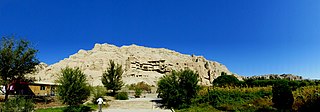
The Kizil Caves are a set of Buddhist rock-cut caves located near Kizil Township in Baicheng County, Aksu Prefecture, Xinjiang, China. The site is located on the northern bank of the Muzat River 65 kilometres west of Kucha. This area was a commercial hub of the Silk Road. The caves have an important role in Central Asian art and in the Silk Road transmission of Buddhism, and are said to be the earliest major Buddhist cave complex in China, with development occurring between the 3rd and 8th centuries CE. The caves of Kizil are the earlier of their type in China, and their model was later adopted in the construction of Buddhist caves further east. Another name for the site has been Ming-oi, although this term is now mainly used for the site of Shorchuk to the east.
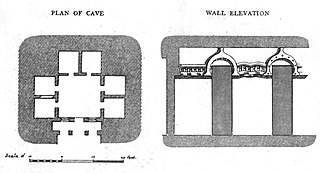
Vihāra generally refers to a Buddhist monastery for Buddhist renunciates, mostly in the Indian subcontinent. The concept is ancient and in early Sanskrit and Pali texts, it meant any arrangement of space or facilities for dwellings. The term evolved into an architectural concept wherein it refers to living quarters for monks with an open shared space or courtyard, particularly in Buddhism. The term is also found in Ajivika, Hindu and Jain monastic literature, usually referring to temporary refuge for wandering monks or nuns during the annual Indian monsoons. In modern Jainism, the monks continue to wander from town to town except during the rainy season (Chaturmas), and the term "vihara" refers to their wanderings.

The Bagh Caves are a group of nine rock-cut monuments, situated among the southern slopes of the Vindhyas in Bagh town of Dhar district in Madhya Pradesh state in central India. These monuments are located at a distance of 97 km from Dhar town. These are renowned for mural paintings by master painters of ancient India. The use of the word "cave" is a bit of a misnomer, since these are not natural, but instead examples of Indian rock-cut architecture.
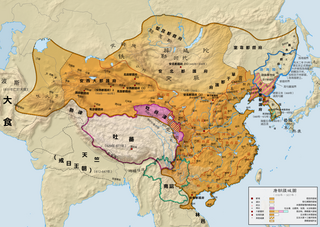
Tokharistan is an ancient Early Middle Ages name given to the area which was known as Bactria in Ancient Greek sources.
The Western Satraps, or Western Kshatrapas were Indo-Scythian (Saka) rulers of the western and central part of India, between 35 to 415 CE. The Western Satraps were contemporaneous with the Kushans who ruled the northern part of the Indian subcontinent, and were possibly vassals of the Kushans. They were also contemporaneous with the Satavahana (Andhra) who ruled in Central India. They are called "Western Satraps" in modern historiography in order to differentiate them from the "Northern Satraps", who ruled in Punjab and Mathura until the 2nd century CE.
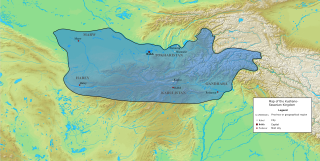
Kushano-Sasanian Kingdom is a historiographic term used by modern scholars to refer to a branch of the Sasanian Persians who established their rule in Bactria during the 3rd and 4th centuries CE at the expense of the declining Kushans. They captured the provinces of Sogdiana, Bactria and Gandhara from the Kushans in 225 CE. The Sasanians established governors for the Sasanian Empire, who minted their own coinage and took the title of Kushanshas, i.e. "Kings of the Kushans". They are sometimes considered as forming a "sub-kingdom" inside the Sasanian Empire. This administration continued until 360-370 CE, when the Kushano-Sasanians lost much of its domains to the invading Kidarite Huns, whilst the rest was incorporated into the imperial Sasanian Empire. Later, the Kidarites were in turn displaced by the Hephthalites. The Sasanians were able to re-establish some authority after they destroyed the Hephthalites with the help of the Turks in 565, but their rule collapsed under Arab attacks in the mid 7th century.

Central Asian art is visual art created in Central Asia, in areas corresponding to modern Kyrgyzstan, Kazakhstan, Uzbekistan, Turkmenistan, Azerbaijan, Tajikistan, Afghanistan, Pakistan, and parts of modern Mongolia, China and Russia. The art of ancient and medieval Central Asia reflects the rich history of this vast area, home to a huge variety of peoples, religions and ways of life. The artistic remains of the region show a remarkable combinations of influences that exemplify the multicultural nature of Central Asian society. The Silk Road transmission of art, Scythian art, Greco-Buddhist art, Serindian art and more recently Persianate culture, are all part of this complicated history.

The Art of Mathura refers to a particular school of Indian art, almost entirely surviving in the form of sculpture, starting in the 2nd century BCE, which centered on the city of Mathura, in central northern India, during a period in which Buddhism, Jainism together with Hinduism flourished in India. Mathura "was the first artistic center to produce devotional icons for all the three faiths", and the pre-eminent center of religious artistic expression in India at least until the Gupta period, and was influential throughout the sub-continent.
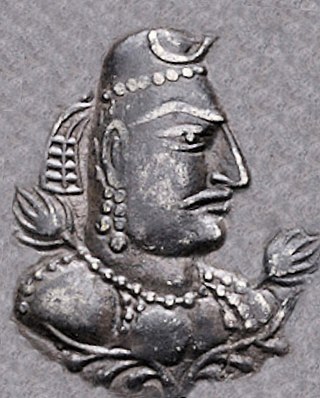
The Alchon Huns, also known as the Alchono, Alxon, Alkhon, Alkhan, Alakhana and Walxon, were a nomadic people who established states in Central Asia and South Asia during the 4th and 6th centuries CE. They were first mentioned as being located in Paropamisus, and later expanded south-east, into the Punjab and central India, as far as Eran and Kausambi. The Alchon invasion of the Indian subcontinent eradicated the Kidarite Huns who had preceded them by about a century, and contributed to the fall of the Gupta Empire, in a sense bringing an end to Classical India.

The Buddhist caves in India. Maharashtra state Aurangabad Dist. Ellora caves form an important part of Indian rock-cut architecture, and are among the most prolific examples of rock-cut architecture around the world. There are more than 1,500 known rock cut structures in India, out of which about 1000 were made by Buddhists, 300 by Hindus, and 200 by Jains. Many of these structures contain works of art of global importance, and many later caves from the Mahayana period are adorned with exquisite stone carvings. These ancient and medieval structures represent significant achievements of structural engineering and craftsmanship.

Gupta art is the art of the Gupta Empire, which ruled most of northern India, with its peak between about 300 and 480 CE, surviving in much reduced form until c. 550. The Gupta period is generally regarded as a classic peak and golden age of North Indian art for all the major religious groups. Gupta art is characterized by its "Classical decorum", in contrast to the subsequent Indian medieval art, which "subordinated the figure to the larger religious purpose".

Kushan art, the art of the Kushan Empire in northern India, flourished between the 1st and the 4th century CE. It blended the traditions of the Greco-Buddhist art of Gandhara, influenced by Hellenistic artistic canons, and the more Indian art of Mathura. Kushan art follows the Hellenistic art of the Greco-Bactrian Kingdom as well as Indo-Greek art which had been flourishing between the 3rd century BCE and 1st century CE in Bactria and northwestern India, and the succeeding Indo-Scythian art. Before invading northern and central India and establishing themselves as a full-fledged empire, the Kushans had migrated from northwestern China and occupied for more than a century these Central Asian lands, where they are thought to have assimilated remnants of Greek populations, Greek culture and Greek art, as well as the languages and scripts which they used in their coins and inscriptions: Greek and Bactrian, which they used together with the Indian Brahmi script.

Balalyk tepe, in former Bactria, modern Uzbekistan, is a Central Asian archaeological site with many mural paintings. It was the site of a small fortified manor belonging to a princely Hephthalite clan. It is generally dated a bit later than the painting at Dilberjin, from the late 5th century to the early 7th century CE, or from the end of the 6th century to the early 7th century CE. The paintings of Balalyk Tepe are part of a "Tokharistan school", which also includes Adzhina-tepe and Kafyr-kala. They are succeeded chronologically by the Sogdian art of Penjikent.
Walter M. Spink was an American art historian who was best known for his extensive study of Buddhist art in India, particularly the Ajanta Caves, a UNESCO World Heritage Site. About his work on the Ajanta caves, scholars have acknowledged that his ideas "revolutionized the history of the site". He was a professor of art history at the University of Michigan, Ann Arbor.

The murals of Penjikent are among the most famous murals of the pre-Islamic period in Panjakent, ancient Sogdiana, in Tajikistan. Numerous murals were recovered from the site, and many of them are now on display in the Hermitage Museum in Saint Petersburg, and in the National Museum of Antiquities of Tajikistan in Dushanbe. The murals reveal the cosmopolitan nature of the Penjikent society that was mainly composed of Sogdian and Turkic elites and likely other foreign merchant groups of heterogeneous origin. Significant similarities with Old Turkic clothing, weapon items, hairstyles and ritual cups are noted by comparative research.

The Fondukistan monastery was a Buddhist monastery located at the very top of a conical hill next to the Ghorband Valley, Parwan Province, about 117 kilometers northeast of Kabul. The monastery dates to the early 8th century CE, with a terminus post quem in 689 CE obtained through numismatic evidence, so that the Buddhist art of the site has been estimated to around 700 CE. This is the only secure date for this artistic period in the Hindu Kush, and it serves as an important chronological reference point.
Hind was the name of a southeastern Sasanian province lying near the Indus River. The boundaries of the province are obscure. The Austrian historian and numismatist Nikolaus Schindel has suggested that the province may have corresponded to the Sindh region, where the Sasanians notably minted unique gold coins of themselves. According to the modern historian C. J. Brunner, the province possibly included—whenever jurisdiction was established—the areas of the Indus River, including the southern part of Punjab.

Indo-Scythian art developed under the various dynasties of Indo-Scythian rulers in northwestern India, from the 1st century BCE to the early 5th century CE, encompassing the productions of the early Indo-Scythians, the Northern Satraps and the Western Satraps. It follows the development of Indo-Greek art in northwestern India. The Scythians in India were ultimately replaced by the Kushan Empire and the Gupta Empire, whose art form appear in Kushan art and Gupta art.























